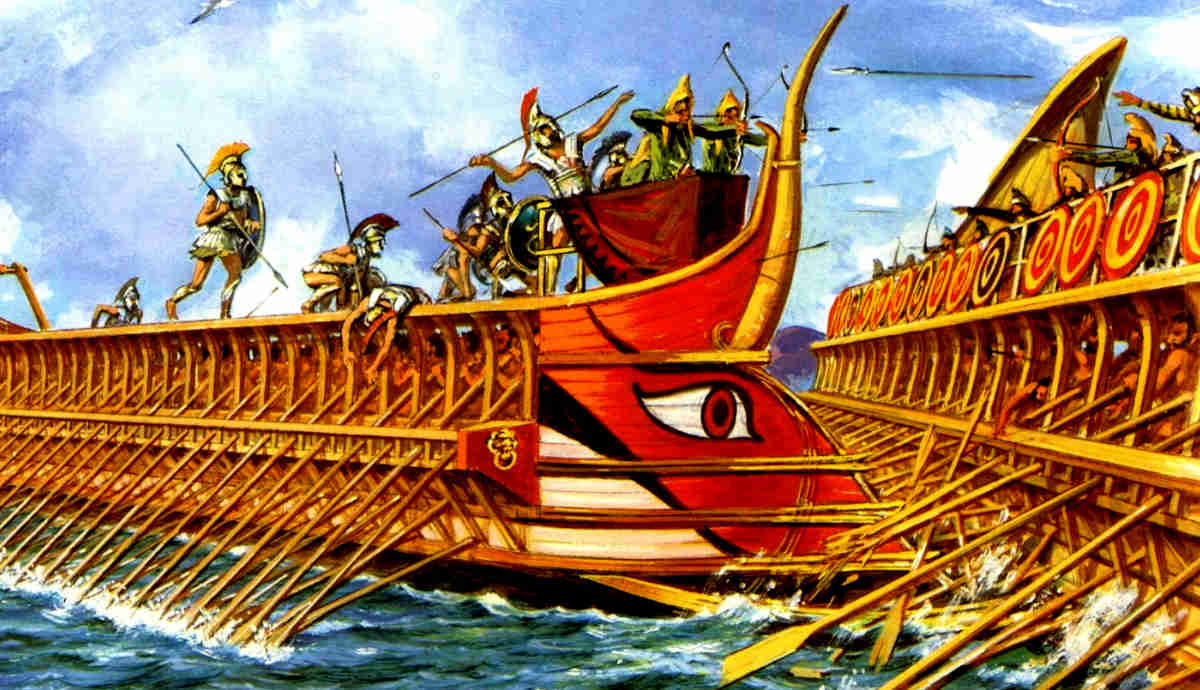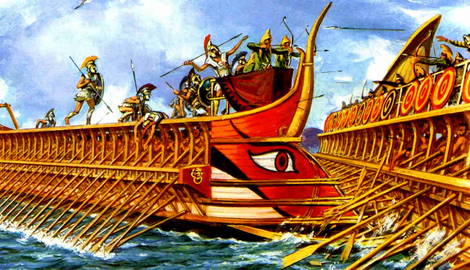
In 480 BCE, the enormous Persian army led by King Xerxes crossed the Hellespont and wound its way down into Greece. While the land forces clashed at Thermopylae, creating a heroic legacy that would endure for millennia, the Greek fleet was tasked with protecting the northern flank of the forces commanded by the Spartan king Leonidas at Thermopylae.
Without the actions of the Greeks at Cape Artemisium, the Thermopylaean shoreline would have been open to a Persian landing. The Battle of Artemisium is, thus, one of the most important battles of the classical Greek era.
Prelude to the Naval Battle of Artemisium

In 480 BCE, during the Greco-Persian Wars, an army of hundreds of thousands of men from across the Persian Empire under the rule of Xerxes I crossed the Hellespont connecting Asia and Europe. Their goal was the complete subjugation of Greece.
The Greek city-states had formed an alliance against their common foe. Together they considered several defensive positions that effectively acted as choke points. There, a smaller Greek army could hold off a much larger force.
The first to be considered was the Vale of Tempe in Thessaly, northern Greece. Ten thousand hoplites were sent to defend the pass. However, on learning of the immense size of the Persian army, and the fact that the choke point could be bypassed by the Sarantaporo Pass, the Greeks retreated and re-evaluated their situation.
The Greek statesman and general Themistocles suggested using the pass at Thermopylae to block the Persian army. The pass was bordered to the south by steep mountain cliffs and to the north by a gently sloping beach. The latter was of particular importance as it would open the Greeks up to being outflanked by the Persian navy, which could simply land men on the shoreline. Thus, to successfully block the Persians at Thermopylae, the Greek navy had to block the Strait of Artemisium.

Against such a massive force, however, it was seen as very likely that the Persians would push through eventually. The question remained as to how long the Greeks could delay them, how many casualties they could inflict, and how they could lower the Persian morale, for after Thermopylae, the whole of Boeotia and Attica would be open to the Persians, and Athens would be undefended.
So while seven thousand Greeks under the command of King Leonidas of Sparta marched north to block Thermopylae, Themistocles ordered the evacuation of Athens and sailed the Greek fleet to the northern point of Euboea, where Cape Artemisium was located.
The Greeks Arrive at Artemisium

When the Greek fleet arrived around August 480 BCE, they beached their ships and kept a vigilant watch over the surrounding waters. Three scout ships were sent northeast to the island of Skiathos, and when the Persian fleet arrived, the scouts lit a beacon that signalled that the Persian fleet had arrived. The scouts, however, were taken by surprise, and of the three ships, two were captured, and one ran aground.
Unsure whether the Persians would make for Thermopylae to support their land troops or sail around the east of Skiathos and make their way to Athens by sailing around Euboea, Themistocles sailed for Chalcis where he would have time to respond to either situation.

The Persian land forces then arrived at Thermopylae but did not attack, instead preferring to wait to see if the Greeks would disperse upon encountering such a massive army. A day later, the Persian fleet was spotted drawing near Artemisium, and it became clear what the Persian decision had been.
Fortune smiled at the Greeks as a huge storm that lasted for two days dashed Persian ships against the rocks. Approximately one-third of the Persian fleet was lost in the storm.
After the winds had died down, the Greeks sailed north to meet their enemies.
The Fleets

According to Greek historian Herodotus, the Persian fleet originally totaled 1207 ships before the storm. He also claims the Persians sent 200 ships around Euboea to block the southern entrance of the Euboean Gulf to deny the Greeks an escape route. This would leave around 600 ships to take on the Greek fleet, which, according to Herodotus, numbered 280 vessels.
The number of Greek ships is, however, unclear. It seems that around 220 ships were available on the first day, while more ships arrived on the second day, after the first engagement, to bring the total to around 280. The Athenians contributed the bulk of the fleet with 127 ships. The Corinthians supplied 40. Despite only supplying ten vessels the Spartans had overall command of the fleet. While the Athenian, Themistocles, wielded great respect, command of the fleet was given to the Spartan, Eurybiades, in order to preserve Greek unity.
The Persian fleet was also drawn from various regions within the Persian Empire. Phoenicia and Syria provided 300 ships, while the Egyptian contingent numbered 200. The Cypriots had 150 ships, while Cilicia, Ionia, and Pontus each provided 100 ships.
It wasn’t just the number of ships that mattered, however. Trireme combat was also a matter of boarding actions and soldiers fighting it out. The Greek ships carried a total of just over 4000 marines, while the Persians had more than 36 000. The vast majority of manpower, however, was not with the soldiers but with the oarsmen. Unlike in the movies, where oarsmen are almost always depicted as slaves, in reality, they were professionals who required skill and training. Estimates put the numbers at around 46 000 for the Greeks and more than 200 000 for the Persians.
Battle Is Joined

With a numerical advantage of almost 3:1, when the Persians spotted the Greek fleet, they seized the initiative and immediately attacked. It was late in the day, but the Persians assumed they would win an easy victory, especially since their crews were seasoned, relative to the Greeks, who needed more time to properly train crews to an equivalent level in their newly built fleet. The Battle of Artemisium had begun.
It is debated what formation the Greeks adopted, but the modern consensus is that they adopted a crescent formation to protect the flanks and negate the Persian tactic of diekplous in which ships would sail directly between the enemy ships and then swing around to ram the enemy vessel near the stern.
When the signal was given, the Greek ships moved forward and engaged the Persians. Their tactic worked better than they could have hoped, and the first engagement ended with 30 Persian ships captured or sunk.
That night, another storm broke out, and with the Persians badly positioned, many of their ships were driven into the shallows, and they suffered another major blow to their numerical superiority.
The Second Day

While the forces at Thermopylae were weathering the Persian storm on land, the Persians at sea were recovering from a literal storm. They made no attempt to attack the Greeks.
The Greeks, too, waited, unsure of the Persian fleet’s situation. While they waited, 53 triremes arrived from Athens. With luck, and reinforcements, the tide was turning in favor of the Greeks. In the afternoon, they caught and destroyed a few Cilician vessels while on patrol.
The Final Engagement

The third and final day of the Battle of Artemisium saw the Persians attempt to attack the Greeks with everything they had. The Greeks tried to block the straits, but their ships were too few. The Persians attempted to envelop them, and the Greeks advanced to engage. The fighting was fierce, and both sides took immense casualties, losing roughly the same number of ships.
At the end of an entire day of fighting, the fleets disengaged and assessed their situation. Despite inflicting heavy casualties on the Persians, the Greeks had lost too many ships, and they doubted whether they would be able to hold the straits for another day. When they received news that the rearguard at Thermopylae had been annihilated, the Greeks withdrew from Artemisium, as there was little reason to hold it.
Herodotus states that throughout the Battle of Artemisium, the most effective fighting came from the Athenian. On the Persian side, the Egyptians fought particularly well, partly because of their armor, which was of equivalent quality to the heavily armored Greek hoplites.
Battle of Artemisium: Conclusion

Although the Greeks failed to stop the Persian advance on both land and sea, the Battle of Artemisium was significant in that it was a proving ground for the relatively green Greek fleet to accrue some experience. This would be invaluable in the Battle of Salamis which was to follow.
It also served to greatly reduce the Persian fleet’s numbers. With a combination of Greek determination, clever thinking, and a great deal of meteorological fortune, the Persians lost around 400 vessels. In contrast, the Greeks lost around 100.
In the end, the Battle of Artemisium, as well as the Battle of Thermopylae, gave the Greeks a fighting chance, allowing them extra time to evacuate Athens. It created the opportunity for another chance to defeat the Persians. And that’s exactly what they did.










